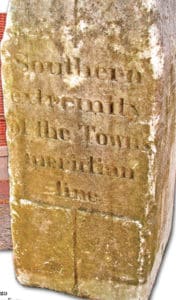~ by Katherine Brooks, Maria Mitchell Association ~
Have you seen stones inscribed with these messages?
“Northern Extremity of the Town’s Meridian Line”
“Southern Extremity of the Town’s Meridian Line”
These two stones are located near the Pacific National Bank and the Fair Street Quaker Meetinghouse in downtown Nantucket. The stones date back to 1840 and have been a standing mystery since the 20th century. Forgotten amongst the cobblestones and other relics that create historic Nantucket, the true purpose of the stones remained a mystery to scientists and towns people alike, the meaning of their purpose lost over time. The mystery of the meridian stones was solved in 2002 by a team of Nantucket Maria Mitchell Association researchers.
Theories of the stones’ original purpose included rating chronometers (accurately timed clocks taken aboard ships to help determine longitude while out at sea) for whaling ships, and even a theory that the stones had no practical use at all. If you took a guided-tour of Nantucket and walked past those stones before the 2002 investigation, you would hear tour guides tell a number of stories and theories about the meaning of the meridian stones. So what are they actually? A meridian line is a line that indicates, “true north” (where the North Pole is geographically), as opposed to “magnetic north,” which is aligned with the Earth’s magnetic field. If you were to use a compass –or pull out your smartphone and open your compass app –that compass (digital or physical) would show you magnetic north. The stones were measured and placed accordingly to create a line that demarcates true north.
The two stones were erected by William Mitchell, a prominent astronomer, teacher, and surveyor on Nantucket in the early 1800’s. He was also the father of the first American woman astronomer, Maria Mitchell. These stones were important for surveying work and were among the first established in the U.S. – quite some time before an act of Congress required states to establish them. Knowing the angle between the stones was important for surveyors and mapmakers who needed to translate between their compass readings and directions on a map. Or, perhaps in the case of William Mitchell, creating exact property lines and translating between both cardinal and magnetic directions to keep the housing and land measurements consistent.

As the team of Maria Mitchell Association researchers began the search for the truth about these mysterious stones, they found public documents from 1840 Nantucket Town Meetings, which indicated that the stones were most likely used as an instrument for public use. The stones have thin lines, which indicated to scientists that the stones might have been used for measuring, and could be a “compass stone.” The team took measurements of the stones through two different methods, and both concluded that the stones were slightly misaligned, which was a curious discovery from a technical observer such as William Mitchell. From public records and documents, measurements, and research, the Maria Mitchell team concluded that the south stone had been removed and replaced for construction and paving projects two separate times. The movement of the stones from their original spot indicates that the stones were likely not replaced accurately, accounting for the misalignment to true north.
What do these stones do now? The stones are historical artifacts and serve as a symbolic monument of astronomical and geographic advances in the early 1800s. The meridian stones are unobtrusive; perhaps you have even passed by the stones without even noticing them. The stones act as a reminder of how integrated our knowledge of the land is with our knowledge of the sky; and of how we take for granted the tools available to us for navigation.
“Meridian markers are reminders of an important period in the history of Western civilization, during which people were learning how to precisely measure the local territory and, eventually, the whole planet.” –Vladimir Strelnitski (Maria Mitchell Observatory Director Emeritus)
The next time you are in Town keep a lookout for these stones and take a minute to orient yourself to ‘true north.’ If you are interested in learning more about Nantucket or the astronomical and geological happenings around you, join the Maria Mitchell Association for fun-filled activities, which connect the past with the present and space with land. On July 20th you can even meet Vladimir Strelnitski, one of the prominent scientists to solve the case of the mysterious meridian stones, and hear one his most popular lectures on the phenomena of polar lights at the MMA Summer Science Speaker Series.
The MMA was founded in 1902 to preserve the legacy of Maria Mitchell and to promote her belief in learning-by-doing. An astronomer and natural scientist, as well as an educator, Maria Mitchell shot to worldwide fame when she discovered a comet in 1846. For her discovery, she was awarded a gold medal from the King of Denmark – the first American and first woman to receive the honor. She served as the Professor of Astronomy and Mathematics at Vassar College from 1865 until 1888. Today, the MMA operates two observatories, a natural science museum, an aquarium, and the birthplace of Maria Mitchell. The MMA conducts scientific research, leads classes and workshops for people of all ages year-round, and welcomes thousands of visitors to its museums and observatories. For details, visit www.mariamitchell.org.